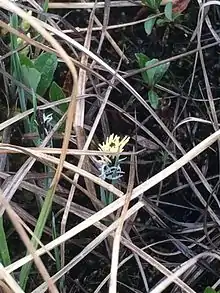| Carex rariflora | |
|---|---|
 | |
| The sedge Carex rariflora. Taken in Atqasuk, Alaska. | |
| Scientific classification | |
| Kingdom: | Plantae |
| Clade: | Tracheophytes |
| Clade: | Angiosperms |
| Clade: | Monocots |
| Clade: | Commelinids |
| Order: | Poales |
| Family: | Cyperaceae |
| Genus: | Carex |
| Species: | C. rariflora |
| Binomial name | |
| Carex rariflora (Wahlenb.) Sm. | |
Carex rariflora, the looseflower alpine sedge,[1] is a species of plant in the sedge family. It is found in the United States in Alaska and Maine, and in Canada in New Brunswick and Nova Scotia.[2] In these regions, it is ranked as an obligate hydrophyte in establishing wetland areas.[3] It prefers wet environments such as open bogs, meadows, seepage slopes, and low-elevation heath tundra.[4] This perennial grass, which can be up to 3 feet tall, has fibrous roots, and holds all perennial organs underground. The leaves are alternate, long, narrow, and simple, with parallel veins.[3] They grow in dense clusters, and the dead leaves are found at the base of the plant.[4] The plant blooms and fruits in the summer. All flowers are monoecious and unisexual, producing a spike inflorescence.[2] All inflorescences are subtended by shorter, proximal bracts.[4]
References
- ↑ USDA, NRCS (n.d.). "Carex rariflora". The PLANTS Database (plants.usda.gov). Greensboro, North Carolina: National Plant Data Team. Retrieved 20 April 2017.
- 1 2 "Lady Bird Johnson Wildflower Center - The University of Texas at Austin". www.wildflower.org. Retrieved 2017-12-23.
- 1 2 "NWPL Home v3.3-c1". wetland-plants.usace.army.mil. Retrieved 2017-12-23.
- 1 2 3 "Carex rariflora in Flora of North America @ efloras.org". www.efloras.org. Retrieved 2017-12-23.